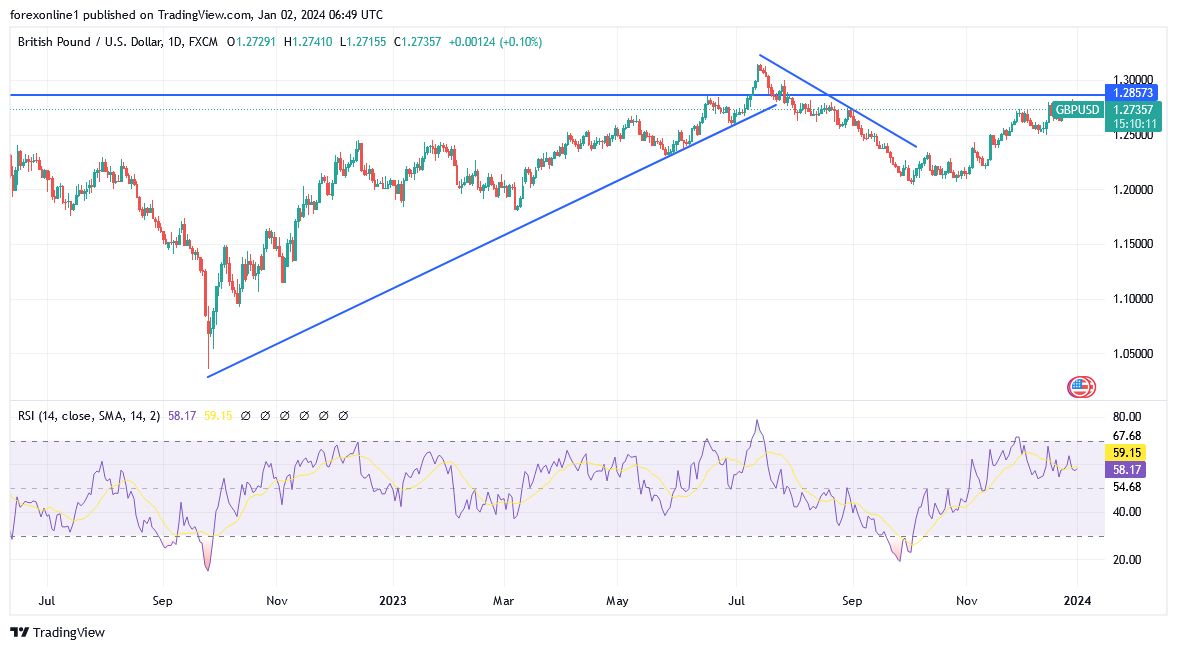The British pound (GBP) against the US dollar (USD) exchange rate saw volatility last week, with a sharp rise on Wednesday towards the resistance of 1.2828, the highest for the pair in five months, before falling on Thursday to the support level of 1.2700. Rising inflation and recession fears weighed on sterling sentiment. As of the writing of this analysis, the GBP/USD is trading at 1.2730, after a slight decline over the past seven days.

The pound traded in a range against the dollar last week, trending higher for the most part but still closing the weekly session below opening levels. Meanwhile, financial markets were closed on December 25, but the GBP/USD saw some movement amid the ongoing conflict in Gaza. The war has escalated, claiming the lives of thousands, and has raised geopolitical tensions around the world.
In addition to suppressing US dollar sentiment, rising bets on successive US interest rate cuts by the Federal Reserve boosted market sentiment, as traders expected fewer impediments to global economic growth. Recently, the price of the GBP/USD reached its highest level in almost 5 months at the start of the European session on Thursday, but quickly retreated to opening levels on Wednesday. Obviously, high inflation rates and recession fears appear to be behind the decline, which was exacerbated by uncertainty over the Bank of England's monetary policy stance.
Last Friday, the British pound was trading in a variable range. A larger-than-expected fall in UK house prices may have fueled volatility, although tailwinds came from elsewhere and US dollar exchange rates traded mixed as risk appetite rebounded. Recently, the US dollar traded mixed against other major currencies last week but faced headwinds at several exchange rates due to a recovery in risk appetite.
Sterling's gains were capped by risk aversion as traders priced in a more dovish path for interest rate hikes from the Federal Reserve. Consequently, growing conviction about a cautious Fed led to further pressure on the GBP/USD pair in midweek, with markets betting on six rate cuts in 2024.
Overall, the British pound-US dollar exchange rate could trade in a wide range this week, but it is likely to be most affected by both the minutes of the latest Federal Open Market Committee (FOMC) meeting and US jobs data on Friday. Moreover, the FOMC minutes could provide insight into the Fed's path for rate cuts this year, which could shake up the dollar's exchange rate. After markets have factored in a number of rate cuts, they may become convinced that their expectations are overblown.
Later, the Bank of England's consumer credit report is expected to show an increase in borrowing, which could raise concerns about the ongoing cost of living crisis or inspire hopes of a recovery in spending in the UK. At the end of the week, unemployment rates are expected to rise in the US, which could weaken US dollar sentiment. Shortly, if non-farm payrolls print lower than the November reading as expected, the dollar could falter.
Top Forex Brokers
GBPUSD Expectations and Analysis Today:
Based on the performance on the daily chart above, bulls are trying to maintain the pace of recent gains for the GBP/USD currency pair until markets and investors react to the important and influential events in the first week of trading in 2024. If events come in favor of further dollar weakness, it is not excluded that the currency pair will move towards the psychological resistance of 1.3000. furthermore, this requires first testing the resistance of 1.2850. On the other hand, in the same time period, breaking the support level of 1.2640 is a threat to the current upward movement.
eady to trade our daily Forex forecast? Here’s a list of some of the top forex brokers UK to check out
